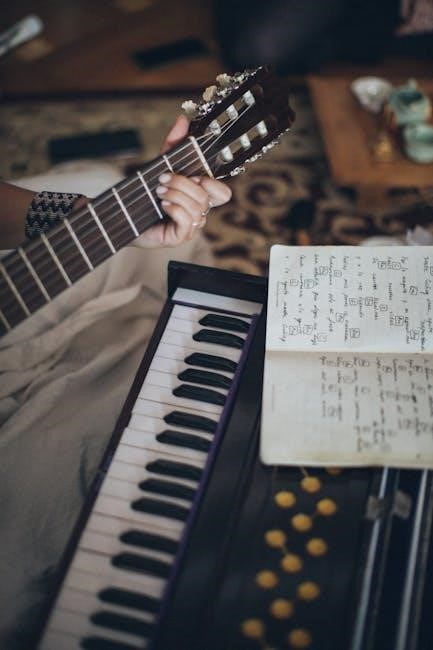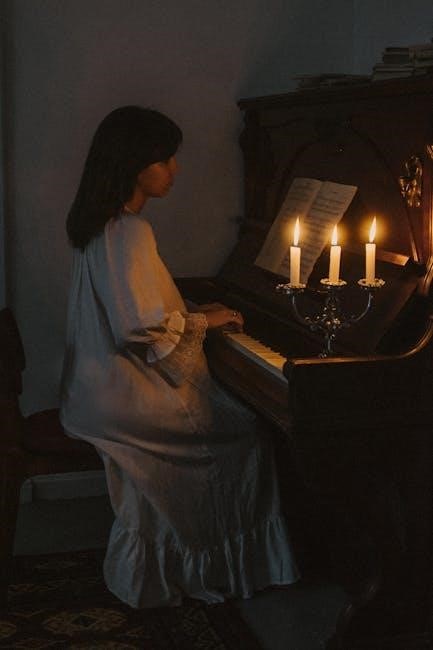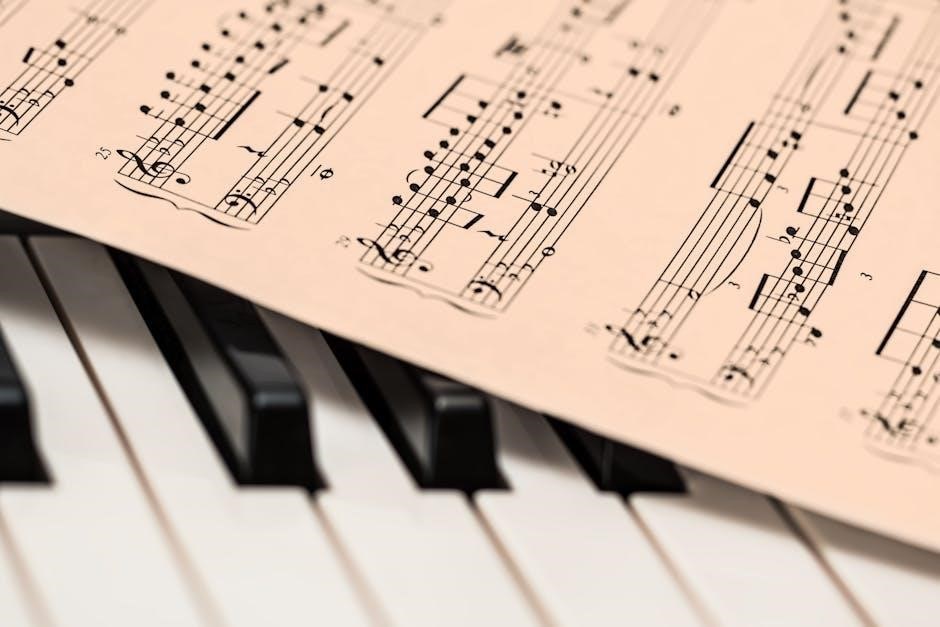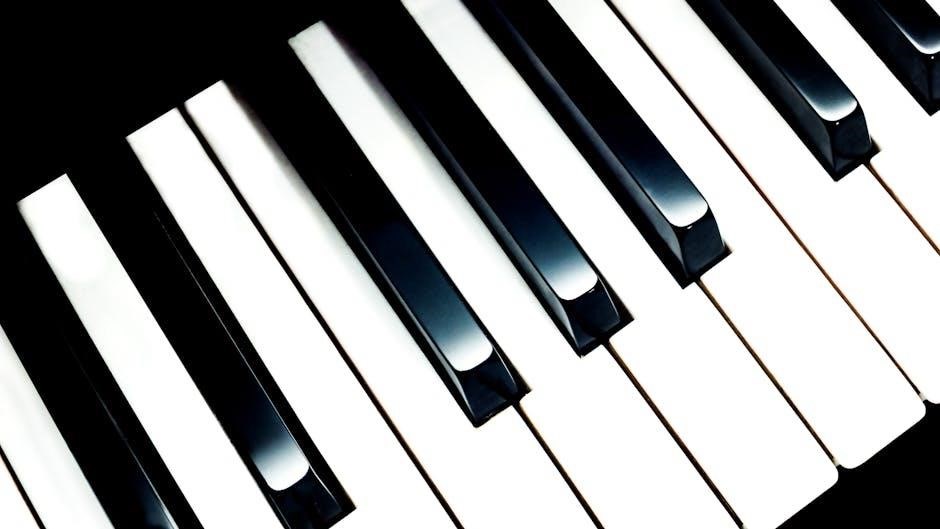Rachmaninoff’s Piano Concerto No. 2, composed between 1900 and 1901, is a cornerstone of Romantic piano repertoire, celebrated for its emotional depth and technical challenges.
Overview of the Concerto
Rachmaninoff’s Piano Concerto No. 2 in C minor, Op. 18, is a three-movement masterpiece showcasing the composer’s emotional depth and technical brilliance. Composed between 1900 and 1901, it features a Moderato first movement, a lyrical Adagio sostenuto, and a vibrant Allegro scherzando finale. The concerto is renowned for its soaring melodies, complex harmonies, and demanding piano part, solidifying its place as a cornerstone of the Romantic piano repertoire.
Significance in Classical Music
Rachmaninoff’s Piano Concerto No. 2 holds a revered place in classical music, celebrated for its emotional intensity, rich melodies, and technical demands. It revitalized Rachmaninoff’s career after a period of creative struggle and solidified his reputation as a master composer. The concerto’s enduring popularity stems from its balance of lyrical beauty and virtuosic brilliance, making it a cornerstone of the Romantic piano repertoire and a favorite among pianists and audiences alike.
Historical Background
Composed between 1900 and 1901, Rachmaninoff’s Piano Concerto No. 2 marked his triumphant return to composition after a psychological crisis. The concerto was dedicated to Dr. Nicolai Dahl, whose therapy helped Rachmaninoff overcome his creative block. Its 1901 premiere restored his reputation, solidifying the work’s historical significance as a turning point in his career.
Composition and Premiere
Rachmaninoff composed his Piano Concerto No. 2 between 1900 and 1901, following a period of personal and creative struggles. The concerto was premiered on November 9, 1901, with Rachmaninoff himself performing as the soloist alongside the Moscow Philharmonic Orchestra, conducted by Alexander Siloti. The second and third movements were first performed earlier, on December 2, 1900, showcasing the composer’s return to form after a challenging period in his career.
Dedication and Revival of Rachmaninoff’s Career
Rachmaninoff dedicated his Piano Concerto No. 2 to Dr. Nikolai Dahl, the hypnotherapist who helped him overcome a psychological breakdown following the failure of his First Symphony. The concerto’s success at its 1901 premiere revitalized Rachmaninoff’s career, restoring his confidence and solidifying his reputation as a master composer. This work marked a triumphant return to form, showcasing his emotional depth and technical brilliance.
Musical Structure
Rachmaninoff’s Piano Concerto No. 2 consists of three movements: Moderato, Adagio Sostenuto, and Allegro Scherzando, showcasing rich melodies, emotional depth, and technical demands, epitomizing Romantic-era complexity.
Movement 1: Moderato
The first movement, marked Moderato, opens with a dramatic orchestral introduction, setting a somber yet majestic tone. The piano enters with a haunting melody, showcasing Rachmaninoff’s mastery of thematic development. The movement follows a sonata form, with contrasting themes that evolve through intricate orchestration. A lyrical secondary theme emerges, providing emotional contrast, while the piano’s virtuosic cadenza highlights technical brilliance. The movement culminates in a powerful climax, blending orchestral and pianistic elements seamlessly, establishing the concerto’s enduring appeal.
Movement 2: Adagio Sostenuto
The Adagio Sostenuto is the emotional heart of the concerto, featuring a lyrical melody introduced by the flute. The piano expands on this theme, creating a rich harmonic tapestry. The movement’s flowing tempo and expressive phrasing highlight Rachmaninoff’s ability to blend technical brilliance with deep sentimentality. The dialogue between the piano and orchestra is intricate, with the strings and woodwinds providing a lush accompaniment. This movement is renowned for its romantic intensity and enduring beauty.
Movement 3: Allegro Scherzando
The Allegro Scherzando is a vibrant, energetic conclusion to the concerto, marked by a playful yet technically demanding character. The movement features intricate piano passages, rapid arpeggios, and a dynamic interplay between the soloist and orchestra. Its lively tempo and virtuosic elements showcase Rachmaninoff’s mastery of both melody and technical brilliance, making it a thrilling finale to the work.

Orchestration
Rachmaninoff’s Piano Concerto No. 2 features a rich orchestration, including strings, double woodwind, timpani, cymbals, and a full brass section, creating a vibrant harmonic texture.
Instruments and Scoring
Rachmaninoff’s Piano Concerto No. 2 requires a full orchestra, including strings, double woodwind (flutes, oboes, clarinets, bassoons), timpani, cymbals, and a brass section of trumpets, horns, trombones, and tuba. The piano part is intricately woven into the orchestration, with complex passages and a dramatic cadenza in the first movement, showcasing both the soloist’s virtuosity and the ensemble’s harmonic richness.
Role of the Piano and Orchestra
The piano dominates as a virtuosic solo instrument, delivering intricate melodies and dramatic cadenzas, while the orchestra provides harmonic depth and emotional contrast. The interplay between the two creates a balanced dialogue, with the orchestra amplifying the piano’s expressive qualities and the piano adding brilliance to the ensemble’s rich textures, forming a pinnacle of Romantic musical collaboration.
Emotional and Technical Challenges
Rachmaninoff’s Piano Concerto No. 2 demands immense emotional expression and technical prowess, with intricate fingerwork, expansive chord progressions, and dramatic dynamic contrasts that test a pianist’s endurance and artistry.
Emotional Depth and Expression
Rachmaninoff’s Piano Concerto No. 2 is renowned for its profound emotional depth, with lush melodies and dramatic contrasts that convey intense personal feeling. The Adagio Sostenuto movement, in particular, showcases a hauntingly beautiful theme that resonates deeply with listeners. The interplay between the piano and orchestra creates a sense of dialogue, heightening the emotional impact. This work reflects Rachmaninoff’s own emotional journey, making it a deeply moving experience for both performers and audiences.
Technical Difficulties for Pianists
Rachmaninoff’s Piano Concerto No. 2 presents significant technical challenges, including intricate fingerwork, double thirds, and demanding chordal passages. The concerto requires a pianist with a large hand span and exceptional stamina. Complex rhythms, rapid arpeggios, and layered textures further test dexterity and control. The third movement, in particular, is notorious for its technical demands, making it a true test of a pianist’s mastery and endurance.

Notable Performances and Recordings
Rachmaninoff’s Piano Concerto No. 2 has been memorably performed by legendary pianists like Vladimir Horowitz and Sergei Rachmaninoff himself. Recordings by Alexandre Tharaud and the Royal Liverpool Philharmonic Orchestra are highly regarded, showcasing the concerto’s enduring appeal and emotional intensity.
Famous Pianists and Their Interpretations
Vladimir Horowitz and Sergei Rachmaninoff himself delivered iconic performances of the concerto. Alexandre Tharaud’s interpretation with the Royal Liverpool Philharmonic Orchestra is also highly acclaimed. Each pianist brings unique emotional depth and technical precision, showcasing the piece’s versatility. Horowitz’s technical brilliance and Rachmaninoff’s lyrical phrasing remain benchmarks, while Tharaud’s modern approach highlights the concerto’s enduring appeal and complexity.
Impact on Musical Legacy
Rachmaninoff’s Piano Concerto No. 2 has left an indelible mark on classical music, solidifying his reputation as a composer. Its emotional depth and technical brilliance have influenced countless pianists and composers. The concerto’s themes have been adapted in popular music, such as Eric Carmen’s “All By Myself,” showcasing its universal appeal. It remains a cornerstone of Romantic repertoire, inspiring new generations of musicians and audiences alike.

Cultural Impact
Rachmaninoff’s Piano Concerto No. 2 has profoundly influenced popular culture, with its melodies featured in various songs and media, enduring as a timeless emotional masterpiece;
Influence on Other Musicians and Composers
Rachmaninoff’s Piano Concerto No. 2 has inspired countless musicians, with its melodies incorporated into popular songs like Eric Carmen’s “All By Myself.” Its emotional depth and technical complexity have influenced composers and pianists, setting a benchmark for Romantic-era works. The concerto’s adaptability has led to transcriptions for various instruments, further cementing its legacy in both classical and popular music, making it a timeless inspiration for artists across genres.
Popularity in Media and Modern Culture
Rachmaninoff’s Piano Concerto No. 2 is widely featured in films, TV shows, and commercials, enhancing emotional scenes with its lush melodies. Its iconic second movement inspired Eric Carmen’s “All By Myself,” later covered by Celine Dion. The concerto’s adaptability has made it a staple in modern media, introducing its timeless beauty to new audiences while remaining a classic in both classical and popular music culture.

Learning and Performance Tips
Mastering Rachmaninoff’s Piano Concerto No. 2 requires meticulous practice, starting from the first measure; Focus on technical passages, dynamics, and phrasing. Use a metronome to ensure precise timing and explore fingerings suitable for your hand span. Begin with slower tempos and gradually increase speed. Practice with orchestral reductions to refine synchronization and balance.
Practical Advice for Pianists
Mastering Rachmaninoff’s Piano Concerto No. 2 demands careful preparation. Begin by studying the score thoroughly, focusing on dynamics, phrasing, and articulation. Practice technical passages slowly, gradually increasing tempo. Use a metronome to ensure precise timing and explore fingerings that suit your hand span. Work on building finger strength and dexterity for complex arpeggios and chords. Additionally, practice with orchestral reductions to refine synchronization and balance.
Mastering the Concerto’s Challenges
Mastering Rachmaninoff’s Piano Concerto No. 2 demands overcoming both technical and interpretive challenges. Focus on tackling complex passages with precision and control, emphasizing dynamic contrasts and phrasing. Practice challenging sections slowly to build accuracy and stamina. Pay attention to orchestral synchronization, as the piano often interweaves with the orchestra. Developing finger strength and dexterity is essential for navigating arpeggios and chords. Additionally, cultivate emotional depth to convey the concerto’s expressive power.

Availability and Resources
Rachmaninoff’s Piano Concerto No. 2 is widely available in digital formats, including PDF scores and study materials. Reliable resources like IMSLP offer the concerto for download, supporting both performance and study.
PDF Scores and Study Materials
PDF scores of Rachmaninoff’s Piano Concerto No. 2 are readily available online, including arrangements for two pianos. Platforms like IMSLP provide free access to high-quality scores, enabling pianists and students to study and perform the concerto. Additional study materials, such as fingerings and orchestral reductions, are also accessible, aiding in preparation for this technically and emotionally demanding work.
Online Resources and Recordings
Online platforms like YouTube and Spotify offer numerous recordings of Rachmaninoff’s Piano Concerto No. 2, featuring renowned pianists such as Alexandre Tharaud and Alexander Vedernikov. Additionally, websites like IMSLP provide free access to PDF scores and study materials, while platforms like Amazon and Apple Music offer high-quality digital recordings for both enjoyment and educational purposes.
Reception and Legacy
Rachmaninoff’s Piano Concerto No. 2 received widespread critical acclaim and audience admiration, solidifying its legacy as a cornerstone of Romantic music. Its emotional depth and technical brilliance continue to inspire pianists and captivate listeners worldwide, making it one of the most beloved concertos in classical repertoire.
Critical Acclaim and Audience Reception
Rachmaninoff’s Piano Concerto No. 2 garnered immediate critical acclaim and audience admiration upon its premiere; Its emotional depth, technical brilliance, and sumptuous orchestration captivated listeners, establishing it as a cornerstone of Romantic music. The concerto’s premiere in 1901 was a triumph, with Rachmaninoff as soloist, leading to its enduring popularity and solidifying its place as one of the most cherished works in classical repertoire.
Enduring Popularity and Influence
Rachmaninoff’s Piano Concerto No. 2 remains a beloved masterpiece, influencing countless musicians and composers. Its melodies, notably borrowed by Eric Carmen for “All By Myself,” highlight its timeless appeal. The concerto’s emotional richness and technical demands make it a favorite among pianists and orchestras, while its beauty captivates diverse audiences, ensuring its enduring presence in classical music repertoire and popular culture.
Interpretations and Variations
Pianists bring unique interpretations to Rachmaninoff’s concerto, while transcriptions for two pianos and other arrangements highlight its versatility. Its melodies have also inspired popular music, like Eric Carmen’s “All By Myself.”
Diverse Interpretations by Pianists
Renowned pianists have uniquely interpreted Rachmaninoff’s concerto, infusing it with personal style. Sergei Rachmaninoff’s own performances set a benchmark, while artists like Vladimir Horowitz and Alexandre Tharaud bring distinct emotional and technical nuances. Each interpretation highlights the work’s versatility, allowing listeners to experience its depth through varied perspectives. These performances showcase the concerto’s enduring appeal and adaptability, ensuring its relevance across generations of musicians and audiences.
Transcriptions and Arrangements
Rachmaninoff’s Piano Concerto No. 2 has inspired various transcriptions and arrangements. The composer himself created a version for two pianos, offering a more intimate interpretation. Other arrangers have adapted the concerto for different ensembles, showcasing its versatility. These transcriptions, including those for solo piano and chamber groups, remain popular among musicians and audiences, demonstrating the work’s enduring appeal and adaptability across musical settings.
